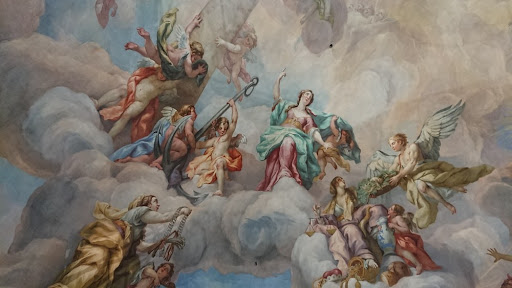
When it comes to art and design, there is a foundational language that includes 7 art principles that help people communicate across all cultures and barriers. These principles are crucial to evaluating the different elements of a piece; they represent how an artist uses the elements of art to create their piece and share their vision.
While the elements of art include shape, color, line, value, form, space, and texture, the principles of art are something a little different. What are the 7 principles of art? Read on here to learn more from the experts at FrameStore.
1. Balance
When experts talk about balance, they’re referring to the way an artist combines the different elements of art to create visual stability and equilibrium within the work. Everyone knows about the most common types of balance — symmetrical and asymmetrical — but you might also hear people talking about radial symmetry. Radial symmetry refers to a piece with different elements placed around a central point in a circular pattern.
You don’t have to be an expert to feel an imbalance in a work of art. If a piece makes you feel visual discomfort, something might be off in the balance principle of art.
2. Movement

The second of the 7 art principles is movement. Have you ever looked at a painting or sculpture and felt like it was moving? An artist has used the elements of art to create a feeling of action because they are guiding your eye through the piece to make it feel more alive.
3. Rhythm
This principle is almost like the heartbeat of a particular piece. It also indicates movement through the careful, repetitive placement of the elements within the work. This visual tempo can make a piece of art evoke different emotions that make a viewer feel the intentions of the artist, whether calm or frantic.
4. Pattern
This component of the 7 principles of art refers to the repetition of a particular design element. The pattern could be varied or exact and helps to establish the rhythm of a piece. Anything could become a pattern through repetition, from dots and spirals to weaves and stripes.
5. Contrast

When defining this principle of the 7 principles of art, experts talk about how the artist arranged the opposite elements in the piece. These opposites may include light and dark, large and small, rough and smooth textures, and negative and positive space.
Areas of contrast generally command your attention as a viewer, and you’ll find that your eye is drawn exactly where the artist wishes it to go.
6. Unity
If every element of the 7 principles of art are harmonious within a given piece, then a viewer has a sense of completion when looking at the work. Artists want their paintings or artwork to feel complete without falling into monotony. There must be a balance between unity and variety, or else a piece feels too boring or too chaotic.
7. Emphasis
The emphasis of a piece of art is where the artist has created a sense of interest. It can use any of the 7 principles of art to draw your eye to a particular place. Some artists use patterns to draw the eye, others prefer to use contrast, and a few like to use rhythm. Each artist has their own ideas for how to emphasize a piece.
Learn More About Art

Now that you know what the 7 principles of art are, you can approach your museum visits with a much more critical eye. Think deeply about how a piece uses these principles to evoke emotion and lead you on a visual journey.